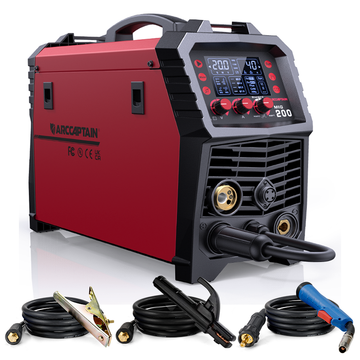Gas Welders
ArcCaptain Gas Welders
ArcCaptain gas welders are your gateway to flawless metalwork, blending the age-old art of welding with modern innovation. Whether you're a professional welder or a passionate hobbyist, our gas welders are built for those who value precision in every bead and joint.
While you're here, don't forget to explore the ArcCaptain exclusive collections of aluminum welders, dual voltage welders, plasma cutters, and protective gear!
Professional Grade Gas Welding Machines
ArcCaptain professional-grade gas welders are equipped to handle the toughest of tasks while providing the finesse needed for detailed work. With ArcCaptain, step up to a robust welding experience, where every flame is a stroke of genius on metal.
Experience Gas Welding Versatility
The versatility of our gas welders means you can weld a variety of metals with confidence. ArcCaptain gas welders are adaptable, reliable, and ready to tackle any project—big or small. The power of versatility is now at your fingertips, offering you the freedom to create without limits.
Portable Gas-Powered Welders
For welders who need to take their craft on the road, ArcCaptain portable gas welders offer an exceptional balance of power and mobility. These machines are designed to be carried to different locations, ensuring that you can deliver top-tier welding performance no matter where your skills are needed.
Easy-to-Use Gas Welding Equipment for Beginners
Beginning welders will find a welcoming introduction to the art of welding with our easy-to-use gas welders. ArcCaptain gas welders offer straightforward functionality that doesn't overwhelm, providing a solid foundation for any novice looking to master the craft with ease and confidence.
Frequently Asked Questions
1 - How hard is gas welding?
Gas welding, also known as oxy-fuel welding or oxyacetylene welding, requires practice to master, particularly because it involves manually controlling a flame and filler material. The process, which utilizes a mixture of oxygen and a fuel gas (usually acetylene) to weld and cut metals, demands a steady hand and an understanding of flame temperature and metal behavior. While considered more challenging than modern welding techniques like MIG or TIG, it offers a foundational understanding of metallurgy and heat control, making it a valuable skill for any welder. With proper training and practice, however, many individuals can become proficient in gas welding.
2 - What is gas welding used for?
Gas welding, also known as oxy-fuel welding, is used for a variety of tasks like cutting, welding, and brazing metals. It's particularly handy for repair work in automotive and general maintenance, metal fabrication, pipe joining in plumbing, creating and fixing jewelry, making metal art and sculptures, and constructing or repairing ships. This type of welding is valued for its ability to precisely control the heat on small areas and its portability, allowing welders to use it in locations without access to electricity.
3 - What is the difference between arc and gas welding?
Arc welding utilizes an electric arc to melt metals and create a weld, while gas welding uses a flame from burning fuel gas and oxygen. Arc welding is often seen as easier for beginners and is widely used in various industries due to its efficiency and strong welds. In contrast, gas welding requires more manual skill to control the flame and is preferred for delicate work, repair jobs, and when portability is needed since it doesn't rely on electricity. Each method serves different needs based on the project's specific requirements.
4 - Why do some MIG welders need gas?
Some MIG (Metal Inert Gas) welders need gas, typically an inert gas like argon or a mixture of argon and carbon dioxide, because it acts as a shielding gas to protect the weld pool from contamination by the atmosphere. Without the shielding gas, the molten metal would react with the oxygen, nitrogen, and hydrogen in the air, causing oxidation, porosity, and other weld defects that can weaken the weld. The gas creates a protective bubble around the arc and weld area, ensuring a cleaner and stronger weld. This is particularly important for welding non-ferrous metals like aluminum or stainless steel, which are more sensitive to oxidation.

